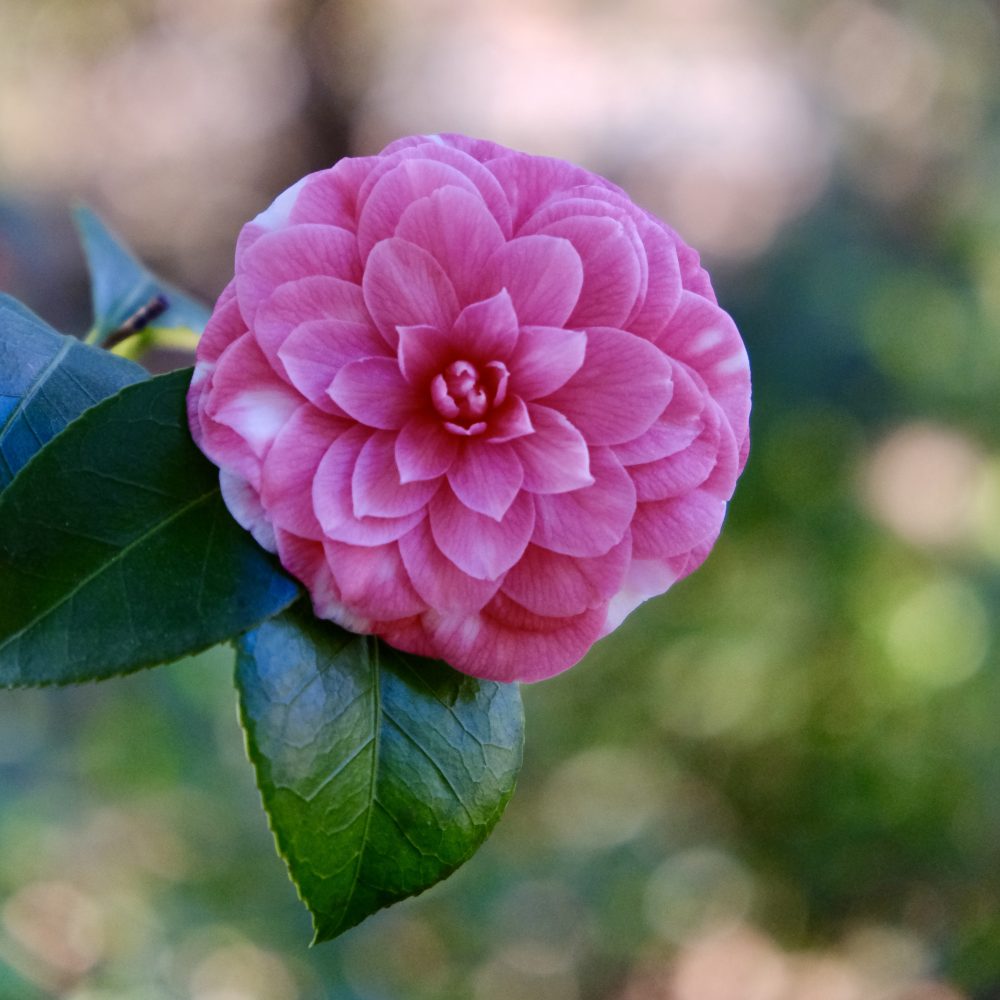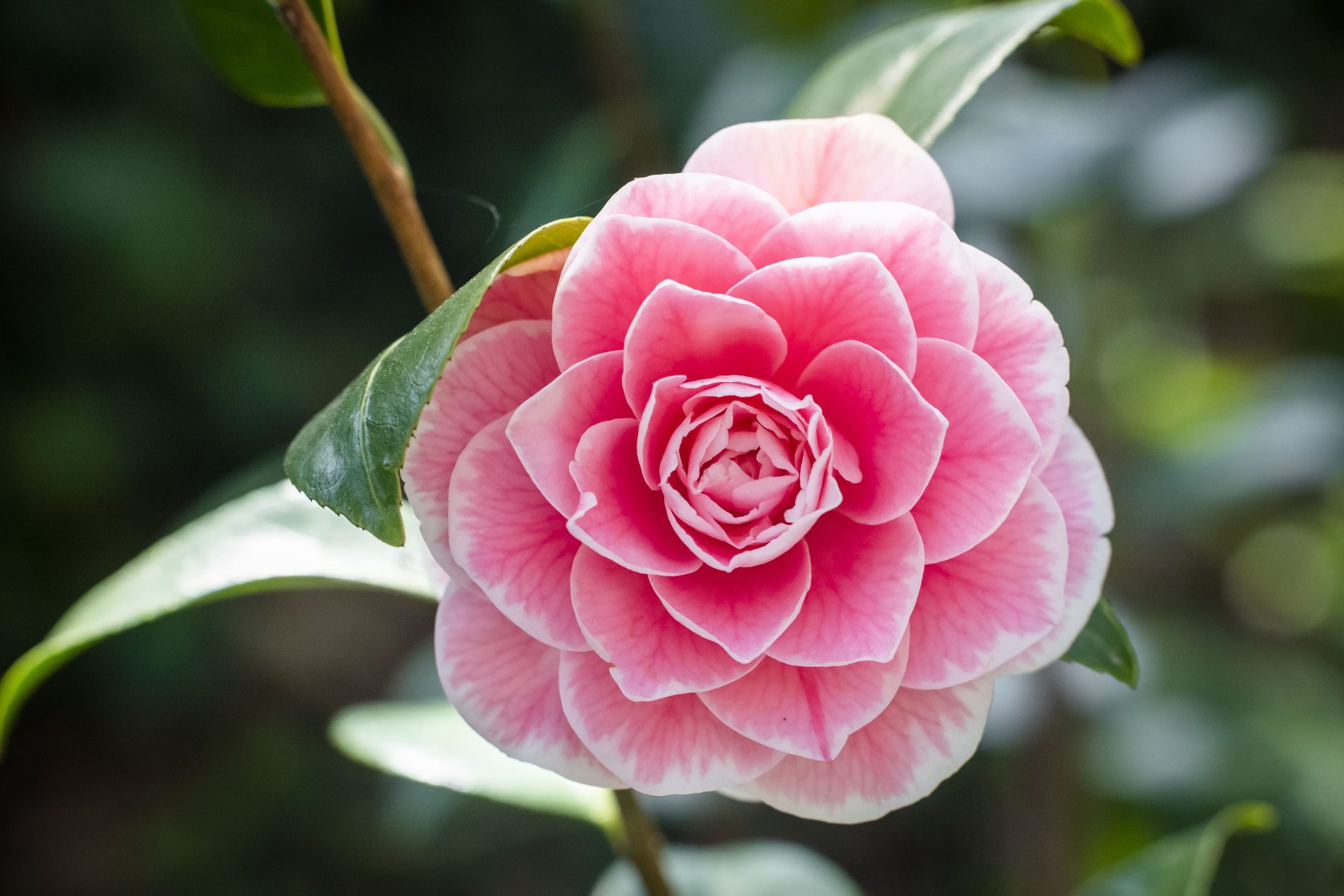The Collections
The Castle Park hosts several important botanical collections, in particular camellias and hydrangeas.
The camellia is like an elegant lady who never goes out of style. Glossy, as if lacquered, it is an aunt with a tea cup, beautiful and artificial like a 19th-century sitting room, adorned with crinolines and fainting spells.
In Piedmont, it has a long history. Towards the end of the 19th century, intense floricultural activity arose around Lake Maggiore, and it is probably from there that century-old specimens of Camellia japonica, which was introduced into the Park by Countess Sofia, originate, as we can see here.
The camellia comes from Asia and has ancient origins. It is fascinating and aristocratic, sometimes simple, sometimes coquettish and complex, in red, pink, or white. The camellia remains silent all year round, then, as if by magic, blooms generously for three weeks in spring, only to drop its flowers to form a characteristic colourful carpet.
Another species, Camellia sasanqua, blooms in the cold. Its characteristic of flowering from late autumn to mid-winter has earned it the nickname “Christmas Camellia.”
The camellia is one of the emblematic flowers of the garden, which motivated the recent introduction of several young specimens of the same species as part of an important project for repopulating the historic garden and safeguarding biodiversity.
The world of hydrangeas is equally vast. They are classified into over 40 species with about 600 varieties. They were introduced to Europe from North America at the end of the 18th century and from the Far East, particularly China and Japan, about a century later.
Hydrangeas, with their striking beauty and delicate charm, remain the undisputed queens of cool, humid garden corners. In the Park, we will encounter many which were beloved to Countess Sofia. Numerous specimens have survived for almost a century.
The hydrangea’s flowering heralds summer, but even in autumn, the leaves and blooms of certain varieties catch the eye, for example the ancient Mariesii perfecta or the Hydrangea macrophylla, specifically the Otaksa variety, whose flowers fade from soft summer tones to shades dusted with gray and green.
Among the Annabelle hydrangeas, we find the charming and time-honored Hydrangea arborescens, a prized presence in cool, moist gardens, still a prima donna among ferns, anemones, and mosses in old, intelligent gardens.
Familiar hydrangeas include those originally planted along the large avenue or, in the shadow of the round tower, the large conical blooms of the Hydrangea paniculata which are bright white at the height of summer. We will also encounter specimens of Hydrangea quercifolia, whose beauty lies especially in its leaves, which resemble oak leaves as they are large, lobed, and leathery.

The Castle Park hosts several important botanical collections, in particular camellias and hydrangeas.
The camellia is like an elegant lady who never goes out of style. Glossy, as if lacquered, it is an aunt with a tea cup, beautiful and artificial like a 19th-century sitting room, adorned with crinolines and fainting spells.
In Piedmont, it has a long history. Towards the end of the 19th century, intense floricultural activity arose around Lake Maggiore, and it is probably from there that century-old specimens of Camellia japonica, which was introduced into the Park by Countess Sofia, originate, as we can see here.
The camellia comes from Asia and has ancient origins. It is fascinating and aristocratic, sometimes simple, sometimes coquettish and complex, in red, pink, or white. The camellia remains silent all year round, then, as if by magic, blooms generously for three weeks in spring, only to drop its flowers to form a characteristic colourful carpet.
Another species, Camellia sasanqua, blooms in the cold. Its characteristic of flowering from late autumn to mid-winter has earned it the nickname “Christmas Camellia.”
The camellia is one of the emblematic flowers of the garden, which motivated the recent introduction of several young specimens of the same species as part of an important project for repopulating the historic garden and safeguarding biodiversity.
The world of hydrangeas is equally vast. They are classified into over 40 species with about 600 varieties. They were introduced to Europe from North America at the end of the 18th century and from the Far East, particularly China and Japan, about a century later.
Hydrangeas, with their striking beauty and delicate charm, remain the undisputed queens of cool, humid garden corners. In the Park, we will encounter many which were beloved to Countess Sofia. Numerous specimens have survived for almost a century.
The hydrangea’s flowering heralds summer, but even in autumn, the leaves and blooms of certain varieties catch the eye, for example the ancient Mariesii perfecta or the Hydrangea macrophylla, specifically the Otaksa variety, whose flowers fade from soft summer tones to shades dusted with gray and green.
Among the Annabelle hydrangeas, we find the charming and time-honored Hydrangea arborescens, a prized presence in cool, moist gardens, still a prima donna among ferns, anemones, and mosses in old, intelligent gardens.
Familiar hydrangeas include those originally planted along the large avenue or, in the shadow of the round tower, the large conical blooms of the Hydrangea paniculata which are bright white at the height of summer. We will also encounter specimens of Hydrangea quercifolia, whose beauty lies especially in its leaves, which resemble oak leaves as they are large, lobed, and leathery.
